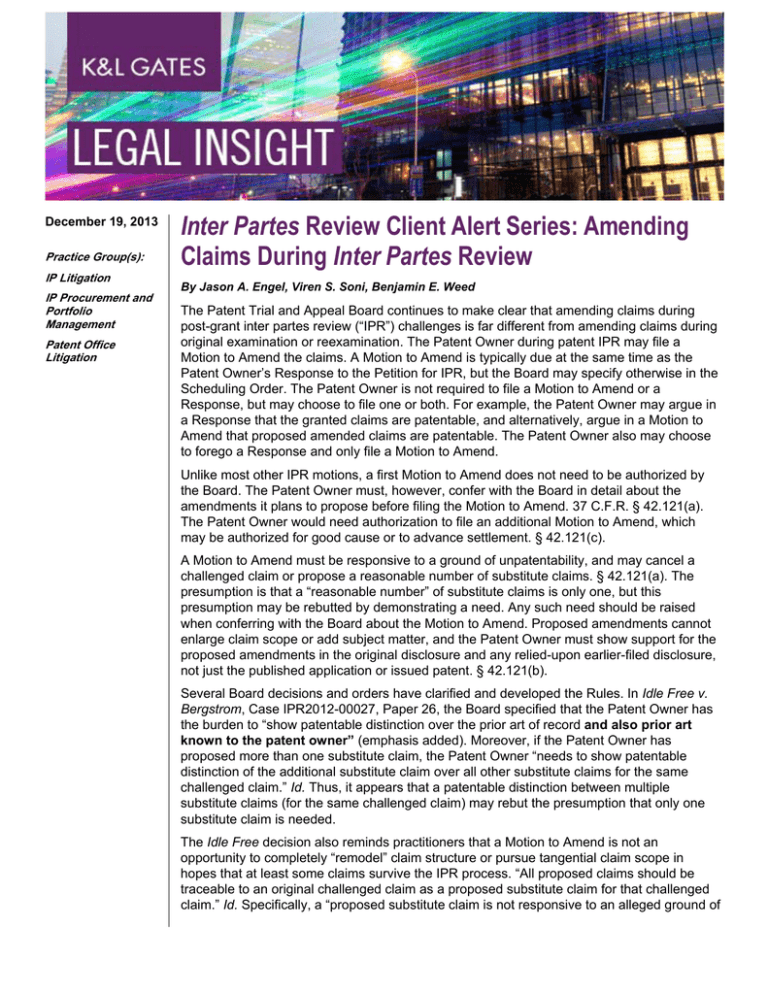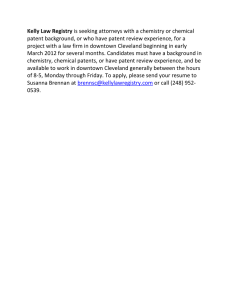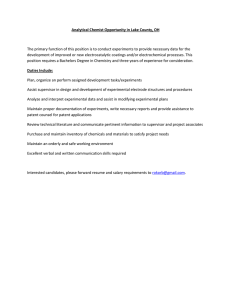
December 19, 2013
Practice Group(s):
IP Litigation
IP Procurement and
Portfolio
Management
Patent Office
Litigation
Inter Partes Review Client Alert Series: Amending
Claims During Inter Partes Review
By Jason A. Engel, Viren S. Soni, Benjamin E. Weed
The Patent Trial and Appeal Board continues to make clear that amending claims during
post-grant inter partes review (“IPR”) challenges is far different from amending claims during
original examination or reexamination. The Patent Owner during patent IPR may file a
Motion to Amend the claims. A Motion to Amend is typically due at the same time as the
Patent Owner’s Response to the Petition for IPR, but the Board may specify otherwise in the
Scheduling Order. The Patent Owner is not required to file a Motion to Amend or a
Response, but may choose to file one or both. For example, the Patent Owner may argue in
a Response that the granted claims are patentable, and alternatively, argue in a Motion to
Amend that proposed amended claims are patentable. The Patent Owner also may choose
to forego a Response and only file a Motion to Amend.
Unlike most other IPR motions, a first Motion to Amend does not need to be authorized by
the Board. The Patent Owner must, however, confer with the Board in detail about the
amendments it plans to propose before filing the Motion to Amend. 37 C.F.R. § 42.121(a).
The Patent Owner would need authorization to file an additional Motion to Amend, which
may be authorized for good cause or to advance settlement. § 42.121(c).
A Motion to Amend must be responsive to a ground of unpatentability, and may cancel a
challenged claim or propose a reasonable number of substitute claims. § 42.121(a). The
presumption is that a “reasonable number” of substitute claims is only one, but this
presumption may be rebutted by demonstrating a need. Any such need should be raised
when conferring with the Board about the Motion to Amend. Proposed amendments cannot
enlarge claim scope or add subject matter, and the Patent Owner must show support for the
proposed amendments in the original disclosure and any relied-upon earlier-filed disclosure,
not just the published application or issued patent. § 42.121(b).
Several Board decisions and orders have clarified and developed the Rules. In Idle Free v.
Bergstrom, Case IPR2012-00027, Paper 26, the Board specified that the Patent Owner has
the burden to “show patentable distinction over the prior art of record and also prior art
known to the patent owner” (emphasis added). Moreover, if the Patent Owner has
proposed more than one substitute claim, the Patent Owner “needs to show patentable
distinction of the additional substitute claim over all other substitute claims for the same
challenged claim.” Id. Thus, it appears that a patentable distinction between multiple
substitute claims (for the same challenged claim) may rebut the presumption that only one
substitute claim is needed.
The Idle Free decision also reminds practitioners that a Motion to Amend is not an
opportunity to completely “remodel” claim structure or pursue tangential claim scope in
hopes that at least some claims survive the IPR process. “All proposed claims should be
traceable to an original challenged claim as a proposed substitute claim for that challenged
claim.” Id. Specifically, a “proposed substitute claim is not responsive to an alleged ground of
Inter Partes Review Client Alert Series: Amending Claims
During Inter Partes Review
unpatentability of a challenged claim if it does not either include or narrow each feature of the
challenged claim being replaced.” Id.
In Avaya Inc. v. Network-1, Case IPR2013-00071, Paper 38, the Board specified that the
Patent Owner should not merely propose amendments, but should also include an
explanation of the significance of the proposed new features to be added. In salesforce.com,
Inc. v. VirtualAgility, Inc., Case CBM2013-00024,1 Paper 19, the Board repeated the high
standard for filing claim amendments. In salesforce.com, the Board explained that the Patent
Owner bears the burden of proof in demonstrating patentability of each proposed substitute
claim, a burden heavier than simply responding to an Examiner’s claim rejections, Id., further
illustrating that post-issuance proceedings are more adjudicative than examinational. The
Patent Owner is also expected to explain the level of ordinary skill with respect to each
added feature, including providing information on whether the feature was known outside of
the claimed combination, in any setting. Id. The Board in Avaya also explained that a “new”
claim including all the limitations of an existing claim would most likely be interpreted as a
substitute claim.
As noted above, the Rules require that a Patent Owner show support in the original or
earliest relied-upon disclosure for each new or amended claim (§ 42.121(b)), and thus,
require compliance with the written description requirement of 35 U.S.C. § 112. The Board’s
order in LaRose Industries, LLC v. Capriola Corp., Case IPR2013-00120, Paper 24, confirms
that a petitioner is permitted “to argue in its opposition to Patent Owner’s motion to amend
that Patent Owner’s proposed substitute claims are unpatentable under 35 U.S.C. § 112, and
to submit new prior art and declarant testimony.” Thus, a Patent Owner should be mindful of
all claim drafting fundamentals, even those not specifically called out in the Rules, such as
indefiniteness or subject matter eligibility.
Finally, although Motions to Amend are subject to the standard 15-page limit on IPR motions,
including claim listings (§§ 42.24(a), 42.121(b)), the Board has shown some flexibility in this
regard. In the LaRose order (discussed above), the Board allowed 22 pages for the Motion to
Amend because the Patent Owner was not filing a response, had included four pages of
figures without text in its Motion to Amend, and did not oppose allowing Petitioner the same
number of pages for its opposition. See also Syntroleum Corp. v. Neste Oil Oyj, Case
IPR2013-00178, Paper 36 (authorizing additional pages for Motion to Amend because
Patent Owner did not file a response). Of course, any request to exceed the 15-page limit
should be discussed with the Board before filing.
1
Although salesforce.com relates to a covered business method patent, the Board’s guidelines for amending claims
should be fully applicable to IPR proceedings.
2
Inter Partes Review Client Alert Series: Amending Claims
During Inter Partes Review
Authors:
Jason A. Engel
jason.engel@klgates.com
+1.312.807.4236
Viren S. Soni
viren.soni@klgates.com
+1.312.807.4358
Benjamin E. Weed
benjamin.weed@klgates.com
+1.312.781.7166
Anchorage Austin Beijing Berlin Boston Brisbane Brussels Charleston Charlotte Chicago Dallas Doha Dubai Fort Worth Frankfurt
Harrisburg Hong Kong Houston London Los Angeles Melbourne Miami Milan Moscow Newark New York Orange County Palo Alto Paris
Perth Pittsburgh Portland Raleigh Research Triangle Park San Diego San Francisco São Paulo Seattle Seoul Shanghai Singapore Spokane
Sydney Taipei Tokyo Warsaw Washington, D.C. Wilmington
K&L Gates practices out of 48 fully integrated offices located in the United States, Asia, Australia, Europe, the Middle East and South
America and represents leading global corporations, growth and middle-market companies, capital markets participants and
entrepreneurs in every major industry group as well as public sector entities, educational institutions, philanthropic organizations and
individuals. For more information about K&L Gates or its locations, practices and registrations, visit www.klgates.com.
This publication is for informational purposes and does not contain or convey legal advice. The information herein should not be used or relied upon in
regard to any particular facts or circumstances without first consulting a lawyer.
©2013 K&L Gates LLP. All Rights Reserved.
3


